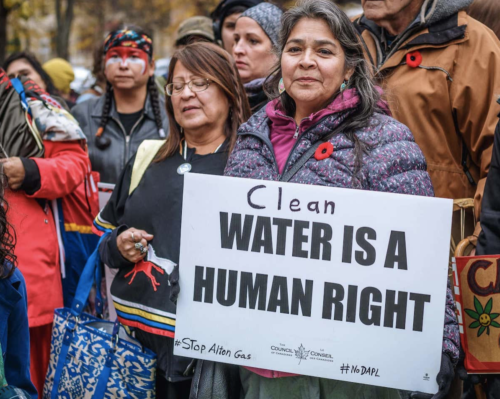
Ducie Howe, a water protector and high school teacher from Mi’kmaq Nation, holds a sign at a protest against the Alton Gas storage project.
Canadians could soon have the legal right to a healthy environment. But can it be enforced?
Carl Meyer, Narwhal, Aug. 10, 2022
The whole post here:
(https://thenarwhal.ca/right-to-healthy-environment-bill-s5/)
From the Narwhal Newsletter:
Residents across Canada could soon have the right to a healthy environment — on paper, at least. In reality? Welllll, you might want to read the fine print, or lack thereof.
The federal government is backing a United Nations resolution to recognize that right by putting forward Bill S-5, legislation it says draws from the same principles as the resolution but which a UN expert says needs to be strengthened to be truly effective.
The Senate took one step in that direction when it pushed for more explicit language in the bill to lay out the federal government’s obligations amid a worsening climate crisis. That triggered, well, the inevitable: seven industry groups lobbied to try to prevent those changes, climate investigations reporter Carl Meyer notes in this explainer:
“It really is worth pointing out how these industry groups just openly lobbied the Senate to roll back amendments they were proposing that would clarify the government’s role in administering the law — things like lobbying against the inclusion of ‘vulnerable environments’ to the list of items the government should consider when deciding whether a substance is toxic,” Carl told me.
It’s still unclear whether MPs will accept those Senate amendments when Parliament returns this fall, tasked with examining and voting on the bill. Even if they do, critics say it’s not enough since the legislation doesn’t actually give someone the right to sue a corporation for causing environmental damages.
Industry impacts are certainly on the mind of Ducie Howe, a Mi’kmaq grandmother and water protector (pictured above) who argues in this new opinion piece that a proposed Nova Scotia LNG export project poses a risk to her people, their unceded lands and the planet.
As for communities that are particularly vulnerable: our team has been writing about the impacts of environmental racism, from higher pollution levels in Toronto’s lower income neighbourhoods to a First Nation in Manitoba grappling with the effects of being moved to a flood-prone area more than a century ago.
Meanwhile, Wilps Gwininitxw, a Gitxsan Nation house group, enshrined its people’s right to a healthy environment this week by declaring an Indigenous Protected Area spanning all 170,000 hectares of its territory. That ecosystem in the upper Skeena River watershed in northwest B.C. is intact right now, but that may not always be the case with two new proposed pipelines on the horizon. And so, “in the absence of meaningful provincial or federal government action,” Wilps Gwininitxw is acting to protect vital habitat.
The outcome of Bill S-5 could have real consequences for how Wilps Gwininitxw, Peguis First Nation, Mi’kmaq Nation and countless other communities seek justice and safety for their people.
———————–


